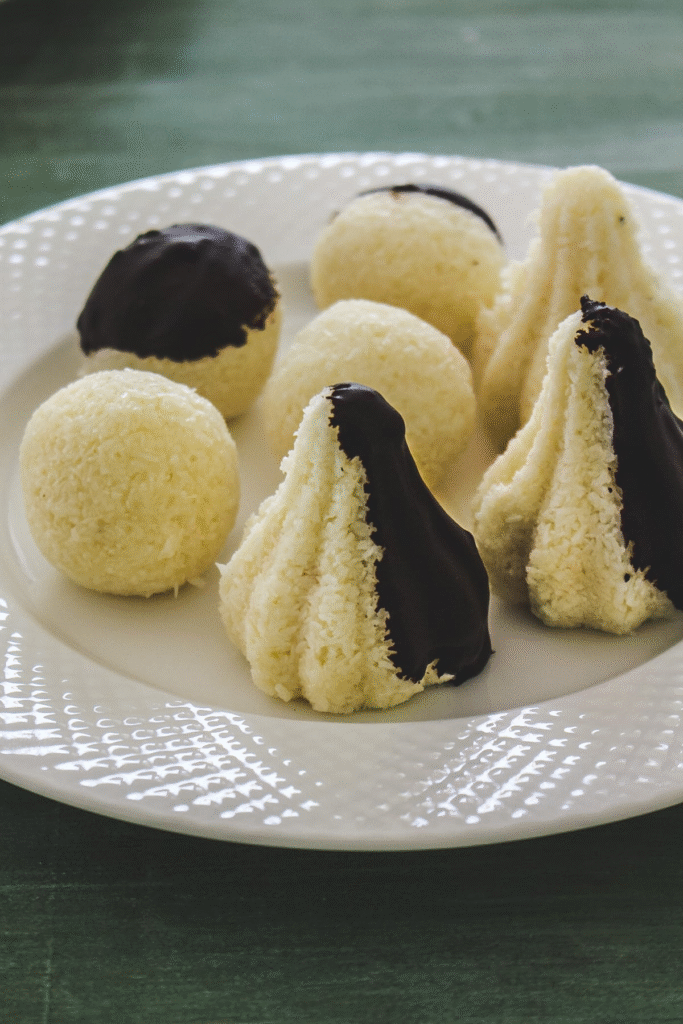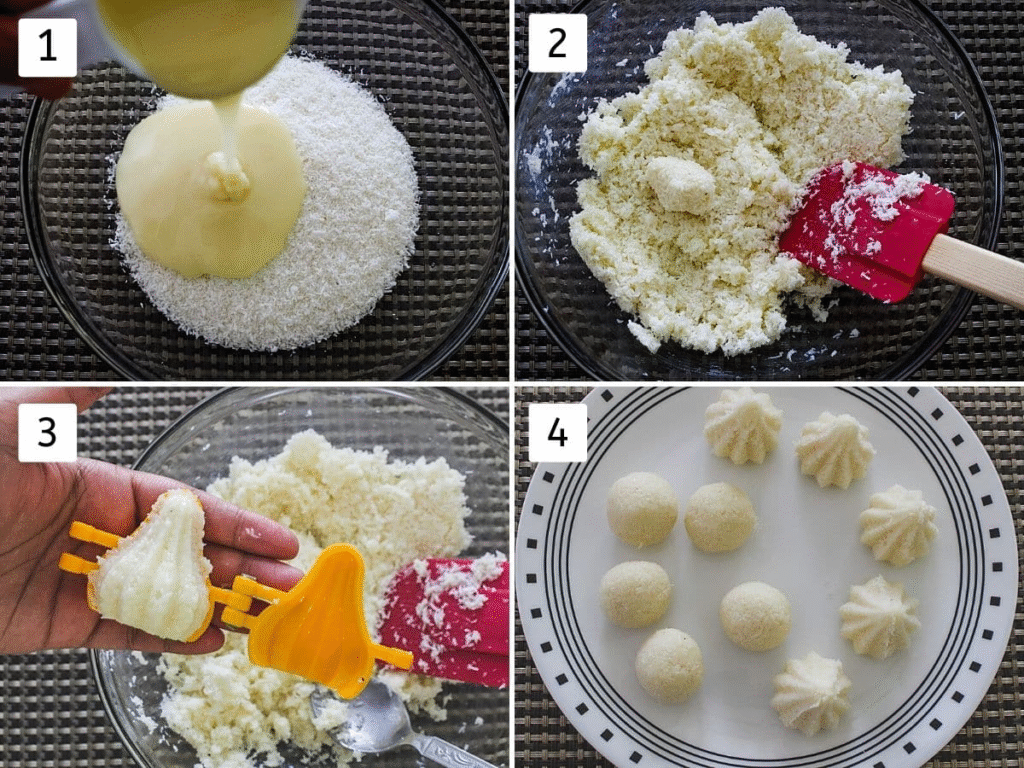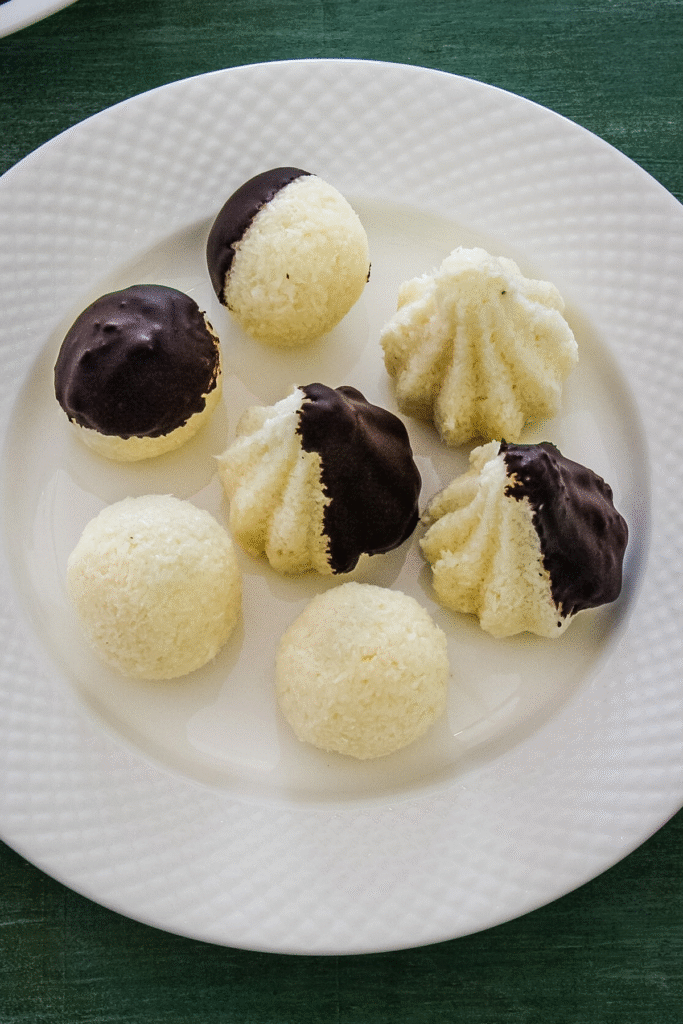Celebrate the auspicious festival of Ganesh Chaturthi with these delightful, quick-to-make Coconut Modak that are packed with traditional flavor and made with a modern twist. Best of all, they require only two basic ingredients: desiccated coconut and condensed milk—making them an ideal last-minute festive recipe that even beginners can master.
If you’re short on time or prefer no-cook sweets, this coconut modak recipe will be your go-to. It takes just 10 minutes or less from start to finish. The mixture comes together effortlessly, and you can mold them into the classic modak shape using a mould or simply roll them into ladoos.

For an extra layer of indulgence, you can dip the modaks in melted chocolate, which adds a lovely fusion twist and makes them irresistible for both kids and adults alike.
Whether you’re preparing bhog (prasad) for Lord Ganesha or looking for an easy Indian sweet to serve during festive gatherings, these coconut modaks are sure to impress with minimal effort. Plus, they’re naturally gluten-free and can easily be customized with rose water, cardamom, or nuts for added richness and variety.
❤️ Why Make On Ganesh Chaturthi
- This coconut modak recipe is perfect for busy festive days—ready in just 10 minutes or less! With so much going on during Ganesh Chaturthi—like decorating the pandal for Lord Ganesha, preparing elaborate meals, sweets, and handling endless festive tasks—this quick and easy sweet is a total lifesaver. It’s the ideal last-minute prasad or festive treat that doesn’t require hours in the kitchen.
- One of the best parts? It’s a no-cook recipe! That’s right—no stove, no complex cooking steps. Just mix the ingredients together and start shaping. It’s truly a fuss-free dessert that even beginners can make without any hassle.
- Worried about getting the perfect modak shape? You don’t need any expertise in traditional moulding. Simply use readymade modak moulds, and you’ll have beautiful, festive-shaped modaks in no time. They make the process super simple and fun, especially if you’re involving kids in festive preparations.
- And if you don’t have modak moulds at home—don’t stress! You can easily roll the mixture into small round balls and turn them into delightful coconut ladoos instead. They taste just as delicious and look equally festive on the plate.
- This versatile and time-saving sweet recipe is a must-try for Ganesh Chaturthi. Whether you make modaks or ladoos, Lord Ganesha is sure to be pleased with your heartfelt offering.
🧾 Ingredients For Coconut Modak
Captured here are the simple ingredients for our quick coconut modak — just two essentials: fresh coconut and condensed milk. For a fun twist, you can optionally dip them in melted chocolate!

- Dry Coconut: This recipe uses dry desiccated coconut, which is a convenient and shelf-stable option, especially perfect for quick and no-cook sweets like this one. Since this is a no-cook version of modak, using dry coconut ensures the mixture binds well without the need for heating. It also absorbs the moisture from condensed milk quickly, making it easier to shape into modaks.
- However, if you prefer to use freshly grated coconut, then this exact recipe won’t be suitable as fresh coconut releases moisture and requires cooking. In that case, you can try a traditional cooked coconut ladoo recipe, where the fresh coconut is sautéed with sweeteners in a pan until it thickens and becomes moldable.
- This recipe calls for sweetened condensed milk for its rich, milky sweetness and ease of use. It’s a wonderful shortcut that helps bind the coconut together without the need for extra sugar or ghee. However, it’s important to note that some people avoid using store-bought or processed ingredients like condensed milk when preparing food for religious offerings, such as during Ganesh Chaturthi or any pooja.
- In such cases, it’s always best to follow your family customs or regional traditions. If you’re unsure whether ready-made condensed milk is acceptable, it’s a good idea to ask your elders or someone in your household who is familiar with these traditions. Some families are perfectly comfortable using it, while others prefer making everything from scratch using only fresh, unprocessed ingredients as a mark of purity and devotion.
- So, if your family avoids store-bought items for festive cooking, you can instead use homemade mawa (khoya) or even a mixture of milk and jaggery cooked down to a thick paste as an alternative. Adjustments like these allow you to honor tradition while still enjoying delicious sweets.
👩🍳 How To Make Coconut Modak Recipe?
Step 1: Combine the Base Ingredients. In a mixing bowl, combine desiccated coconut with sweetened condensed milk. Stir vigorously until all the ingredients combine into a cohesive, sticky mass with a smooth and even texture throughout. To check if it’s ready, take a small amount and press it between your fingers—if it forms a firm ball without falling apart, it’s good to go. If the mixture feels too dry or isn’t binding well, add a teaspoon of milk and mix again until it reaches the perfect consistency.
Step 2: Prepare and Fill the Modak Mould. Grease your modak mould lightly with a dab of ghee to ensure effortless release. Snap the mould shut and pack in the coconut mixture from the bottom, pressing firmly so it captures all the fine details of the design. Carefully open the mould and release the modak gently to retain its beautiful design.
Step 3: Shape Alternatives. No mould? No worries! Roll the mixture into round, smooth ladoos using your palms—just as delicious and festive.
Step 4: Melt the Chocolate. Break semi-sweet chocolate into pieces and place them in a microwave-safe bowl. Microwave in short bursts of 10–15 seconds, stirring between each interval, until the chocolate is fully melted, glossy, and lump-free. Alternatively, you can melt the chocolate using the double boiler method over stovetop heat.

Step 5: Add the Chocolate Coating. Once your modaks (or ladoos) are shaped, dip each one halfway into the melted chocolate. Let the excess drip off and place it on a parchment-lined plate or tray. Want to go full indulgence? Dip the entire modak in chocolate for a rich treat.
Step 6: Let It Set. Let the chocolate coating firm up naturally by leaving it at room temperature for around an hour. This slow setting process helps the coating achieve a smooth, glossy finish without the need for refrigeration. If you’re short on time, refrigerate the modaks for 15–20 minutes until the chocolate firms up.

📖 Variations For Coconut Modak
Rose-Flavored Filling Tip: For a delightful twist, place about a teaspoon of gulkand (rose petal preserve) in the center of each modak for a burst of floral sweetness. Curious about how to stuff them neatly? Refer to the detailed step-by-step visuals in the mawa modak recipe to guide you through the shaping and filling process with ease.
Flavoring the coconut modak mixture (choose anyone):
- Pour in 1 teaspoon of fragrant rose water to lend a subtle floral essence to the mixture.
- Sprinkle in ¼ teaspoon of freshly ground cardamom for a warm, aromatic depth that enhances traditional Indian flavors.
- Add 2 teaspoons of saffron milk — simply soak a few strands of saffron in warm milk for 10 minutes to release their golden color and rich aroma.
- Next, mix in 1½ tablespoons of rose syrup or Rooh Afza for a vibrant hue and a burst of sweet, rosy flavor.
- Toss in 2 to 3 tablespoons of finely chopped or ground pistachios—or use a mix of your favorite nuts—for added texture and nutty richness.
- To finish, blend in 2 to 3 tablespoons of Hershey’s chocolate syrup or strawberry syrup based on your preference. If using this, be sure to reduce the condensed milk by the same amount to maintain the perfect consistency and sweetness.

Instructions
- Prepare the Modak Mixture:
- In a mixing bowl, combine desiccated coconut with sweetened condensed milk.
- Stir the mixture thoroughly until well blended. Test by pressing a small portion between your fingers—if it binds easily into a soft ball, it’s ready. If it feels too crumbly or dry, add a splash of milk and mix again to achieve the right consistency.
2. Shape the Modak:
- Lightly grease your modak mould with a bit of ghee to prevent sticking.
- Close the mould and fill it tightly with the coconut mixture, pressing it firmly from the open base so it takes the intricate shape.
- Gently open the mould and release the shaped modak with care.
- Repeat the same process with the remaining mixture. If you don’t have a mould, you can simply roll the mixture into smooth, firm ladoo balls using your hands.
3. Chocolate Coating:
- Chop the semisweet chocolate into small chunks and transfer them to a microwave-safe bowl. This helps the chocolate melt evenly and prevents overheating.
- Melt the chocolate in the microwave in short intervals of 10–15 seconds, stirring after each interval. Continue this process until the chocolate is silky smooth and fully melted. For a smoother, more controlled melt, try using the double boiler method on the stovetop.
- Once melted, dip each modak halfway into the chocolate, allowing the excess to drip off before placing them on a plate lined with parchment paper. If preferred, you can coat the entire modak for a fully chocolatey version.
- Let the chocolate set at room temperature for about an hour, or place the tray in the refrigerator to speed up the setting process.
